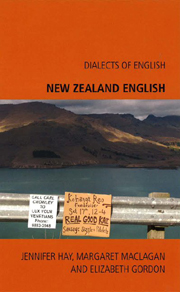Book contents
- Frontmatter
- Contents
- Preface
- Maps
- 1 Geography, Demography and Cultural Factors
- 2 Phonetics and Phonology
- 3 Morphosyntax
- 4 New Zealand Vocabulary and Discourse Features
- 5 The Origins of New Zealand English
- 6 Variation within New Zealand
- 7 Selected Bibliography of Works on New Zealand English
- 8 Sample Texts
- Bibliography of Cited Works
- Index
4 - New Zealand Vocabulary and Discourse Features
Published online by Cambridge University Press: 12 September 2012
- Frontmatter
- Contents
- Preface
- Maps
- 1 Geography, Demography and Cultural Factors
- 2 Phonetics and Phonology
- 3 Morphosyntax
- 4 New Zealand Vocabulary and Discourse Features
- 5 The Origins of New Zealand English
- 6 Variation within New Zealand
- 7 Selected Bibliography of Works on New Zealand English
- 8 Sample Texts
- Bibliography of Cited Works
- Index
Summary
This chapter will concentrate primarily on vocabulary, discussing a range of lexical items that together characterise New Zealand English. At the end of the chapter, we will also look briefly at distinctive discourse features of New Zealand English – including the use of particular discourse markers (e.g. ‘eh’), as well as some conversational strategies New Zealanders use in interaction.
New Zealand vocabulary
In 1679, Captain James Cook and the crew of his ship Endeavour made landfall on the east coast of the North Island of New Zealand. On this and two subsequent visits Cook and his men wrote in their journals about their association with local Maori. On the first voyage, they were accompanied by a Tahitian man named Tupia and a young Tahitian boy named Taiata. Tupia was familiar with Polynesian dialects, claiming to know more than 100 South Sea Islands. He acted as an interpreter for the explorers and from the very first meeting with Maori this proved to be invaluable. Cook wrote ‘Tupia spoke to them in his own language and it was an agreeable surprise to us to find that they perfectly understood him’ (9 October 1769, Reed and Reed 1969: 35). John Hawkesworth, who accompanied Cook, also wrote about this event (Hawkesworth 1773). ‘Tupia was again directed to speak to them, and it was with great pleasure that we perceived that he was perfectly understood, he and the natives speaking only different dialects of the same language’ (Vol 2: 287).
- Type
- Chapter
- Information
- New Zealand English , pp. 65 - 83Publisher: Edinburgh University PressPrint publication year: 2008



